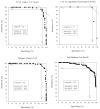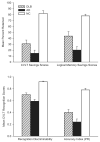Neuropsychological assessment of dementia
- PMID: 18616392
- PMCID: PMC2864104
- DOI: 10.1146/annurev.psych.57.102904.190024
Neuropsychological assessment of dementia
Abstract
Neuropsychological studies show that cognitive deficits associated with Alzheimer's disease (AD) are distinct from age-associated cognitive decline. Quantitative and qualitative differences are apparent across many cognitive domains, but are especially obvious in episodic memory (particularly delayed recall), semantic knowledge, and some aspects of executive functions. The qualitatively distinct pattern of deficits is less salient in very old AD patients than in younger AD patients. Although decline in episodic memory is usually the earliest cognitive change that occurs prior to the development of the AD dementia syndrome, asymmetry in cognitive abilities may also occur in this "preclinical" phase of the disease and predict imminent dementia. Discrete patterns of cognitive deficits occur in AD and several neuropathologically distinct age-associated neurodegenerative disorders. Knowledge of these differences helps to clinically distinguish among various causes of dementia and provides useful models for understanding brain-behavior relationships that mediate cognitive abilities affected in various neurodegenerative diseases.
Figures





References
-
- Albert MS, Blacker D. Mild cognitive impairment and dementia. Annu Rev Clin Psychol. 2006;2:379–88. - PubMed
-
- Albert MS, Moss MB, Tanzi R, Jones K. Preclinical prediction of AD using neuropsychological tests. J Int Neuropsychol Soc. 2001;7:631–39. - PubMed
-
Measures of episodic memory and executive function predicted the development of dementia within three years in patients with mild memory difficulty.
-
- Alexander GE, DeLong MR, Strick PL. Parallel organization of functionally segregated circuits linking basal ganglia and cortex. Annu Rev Neurosci. 1986;9:357–81. - PubMed
-
- Bäckman L, Jones S, Berger AK, Laukka EJ, Small BJ. Multiple cognitive deficits during the transition to Alzheimer's disease. J Intern Med. 2004;256:195–204. - PubMed
-
A review showing that multiple cognitive domains (i.e., episodic memory, executive function, and perceptual speed) are adversely affected several years before a clinical diagnosis of AD.
-
- Bäckman L, Jones S, Berger AK, Laukka EJ, Small BJ. Cognitive impairment in preclinical Alzheimer's disease: a meta-analysis. Neuropsychology. 2005;19:520–31. - PubMed
Publication types
MeSH terms
Grants and funding
LinkOut - more resources
Full Text Sources
Medical

